- Home
- Devdutt Pattanaik
Jaya: An Illustrated Retelling of the Mahabharata
Jaya: An Illustrated Retelling of the Mahabharata Read online
DEVDUTT PATTANAIK
Jaya
An Illustrated Retelling of the
Mahabharata
PENGUIN BOOKS
Contents
Dedication
Author’s Note: What Ganesha Wrote
Structure of Vyasa’s Epic
Prologue: The Start of the Snake Sacrifice
1. Ancestors
2. Parents
3. Birth
4. Education
5. Castaway
6. Marriage
7. Friendship
8. Division
9. Coronation
10. Gambling
11. Exile
12. Hiding
13. Gathering
14. Perspective
15. War
16. Aftermath
17. Reconstruction
18. Renunciation
Epilogue: The End of the Snake Sacrifice
The Idea Called Dharma
Bibliography
Acknowledgements
Copyright Page
I dedicate this book to all the scholars, authors, archivists,
playwrights, film-makers and storytellers, both ancient and modern,
who have worked towards keeping this grand and ancient epic
alive through their songs, dances, stories, plays, novels,
performances, films and teleserials for over 3000 years
Author’s Note
What Ganesha Wrote
They were perhaps whispers of God, or maybe insights of the wise. They gave the world meaning and life a purpose. These chants relieved vedana, the yearning of the restless human soul, hence became collectively known as the Veda. Those who heard them first came to be known as the Rishis.
Based on what the Veda revealed, the Rishis created a society where everything had a place and where everything changed with rhythmic regularity. The Brahmans were the teachers of this society, the Kshatriyas its guardians, the Vaishyas its providers and the Shudras its servants.
Thanks to the Veda, everyone in this society knew that the life they led was just one of many. In other lives, past or present, the Shudra of this life would be a Vaishya, and the Kshatriya would be a Brahman, or perhaps a rock or plant or beast, maybe even a god or a demon. Thus everything was interconnected and everything was cyclical. The point of existence in this dynamic, ever-changing world then was not to aspire or achieve, but to introspect.
Then there was a drought, a terrible fourteen-year drought, when the river Saraswati dried up, the society collapsed, and the Veda was all but forgotten. When the rains finally returned, a fisherwoman’s son, born out of wedlock, took it upon himself to compile the scattered hymns. His name was Krishna Dwaipayana which means the dark child who was born on a river island. His father was Parasara, grandson of the great Vasishtha, one of the seven Rishis who heard the Veda first. In time, Krishna Dwaipayana became known as Veda Vyasa, compiler of the books of wisdom.
Vyasa classified the hymns and created four collections—Rig, Yajur, Sama and Atharva. On completing this monumental task, Vyasa had this inexplicable urge to write a story, one that would convey the most abstract of Vedic truths to the simplest of men in the farthest corners of the world in the most concrete of forms. The gods liked the idea and sent the elephant-headed Ganesha to serve as his scribe.
Ganesha said, ‘You must narrate without a pause.’ This would ensure that what Vyasa dictated was not adulterated by human prejudice.
‘I will,’ said Vyasa, ‘provided you write nothing unless it makes sense to you.’ This ensured that all that was written appealed to the divine.
The characters of Vyasa’s tale were people he knew. The villains, the Kauravas, were in fact his own grandchildren.
Vyasa called his tale Jaya, meaning ‘the tale of a victory’. It had sixty portions. Of these, only one part reached humans through Vyasa’s student, Vaisampayana. Thus no one really knows everything that Vyasa narrated and Ganesha wrote down.
Vaisampayana narrated Vyasa’s tale at the yagna of Janamejaya, the great grandson of the Pandava Arjuna. This was overheard by a Sauti or bard called Romaharshana, who passed it on to his son Ugrashrava, who narrated it to Shonak and the other sages of the Naimisha forest.
Vyasa also narrated the story to his son, the parrot-headed Suka, who narrated it to Parikshit, Janamejaya’s father, comforting him with its wisdom as he lay dying.
Jaimini, another of Vyasa’s students, also heard his teacher’s tale. But he was confused. Since Vyasa was not around to clarify his doubts, Jaimini decided to approach Markandeya, a Rishi blessed with long life, who had witnessed the events that had inspired Vyasa’s tale. Unfortunately, by the time Jaimini found Markandeya, the sage had renounced speech as part of his decision to renounce the world. Markandeya’s pupils then directed Jaimini to four birds who had witnessed the war at Kuru-kshetra. The mother of these birds was flying over the battlefield when she was struck by an arrow that ripped open her womb. Four eggs fell out and fell to the ground. The ground was bloodsoaked, hence soft. The eggs did not break. The bell of a war-elephant fell on top of them and protected them through the battle. When they were discovered after the war, the Rishis realized the birds had heard much during the war and knew more than most humans. Their perspective and insights would be unique. So they were given the gift of human speech. Thus blessed, these birds were able to talk and clarify Jaimini’s doubts. They also told Jaimini many stories that no one else knew.
As Vyasa’s tale moved from one storyteller to another, new tales were added, tales of ancestors and descendants, of teachers and students, of friends and foes. The story grew from a tiny sapling into a vast tree with many branches. At first it was about an idea. Then the idea changed and it came to be known as Vijaya. Before long it became not about any idea but about people. It was retitled Bharata, the story of the Bharata clan and the land they ruled.
The expansion continued. Detailed conversations on genealogy, history, geography, astrology, politics, economics, philosophy and metaphysics were included. The Bharata came to have eighteen chapters and over a hundred thousand verses. Even the story of Krishna’s early years, the Harivamsa, was added as an appendix. That is how the Bharata came to be the Mahabharata, the ‘great’ epic of the Indian people.
Over the centuries, the Mahabharata has been retold a hundred thousand times, in temple courtyards and village fairs, in various languages, in different forms, by dancers, singers, painters, wandering minstrels and learned scholars. As the epic spread from Nepal in the north to Indonesia in the south, old plots were changed and new characters emerged. There was Arjuna’s son, Iravan, also known as Iravat or Aravan, who was worshipped by the transgender Alis or Aravanis of Tamil Nadu and Bhima’s son, Barbareek, who was worshipped in Rajasthan as Khatu Shyamji. In the Mahabharata of Bengal, there surfaced a tale of Draupadi leading an army of women and routing the Kauravas after the death of Abhimanyu. Theyyam performers of Kerala sang of how the Kauravas compelled a sorcerer to perform occult rites against the Pandavas, and how this was reversed by the sorcerer’s wife.
In the 20th century, the epic cast its spell on the modern mind. Long essays were written to make rational sense of its moral ambiguity, while its plots were used by novelists, playwrights and film-makers as potent vehicles to comment on numerous political and social issues—from feminism to caste to war. Its wisdom has often been overshadowed by its entertainment value, its complexities oversimplified by well-meaning narrators, leading to ruptures in the traditional discourse.
With so many retellings and so widespread a popularity, some argue that the Mahabharata actually me
ans the tale of the greatness of India, and not the great epic of India, for it contains all that has made Indians what they are—a tolerant people who value inner wisdom over outer achievement.
This book is yet another retelling of the great epic. Inspired by both the Sanskrit classic as well as its regional and folk variants, it is firmly placed in the context of the Puranic worldview. No attempt has been made to rationalize it. Some tales in the epic are sexually explicit, and need to be read by children only under parental guidance. The exile in the forest (Vana Parva), the song of Krishna (Bhagavad Gita) and Bhishma’s discourse (Shanti Parva and Anushasan Parva) have had to be summarized, so they remain true to the original only in spirit. The Ashwamedha Parva is based on Jaimini’s retelling, hence focuses more on the doctrine of devotion rather than the military campaign.
Shaped by my own prejudices as well as the demands of the modern reader, restructured for the sake of coherence and brevity, this retelling remains firmly rooted in my belief that:
Within infinite myths lies the Eternal Truth
Who sees it all?
Varuna has but a thousand eyes
Indra, a hundred
And I, only two
Most people believe that the epic was inspired by a real war that was fought amongst nomadic herdsmen, who followed the Vedic way of life and grazed their cattle in the north of modern-day Delhi, probably in what is now the town of Kuru-kshetra in the state of Haryana.
According to the Aihole inscription of the famous Chalukya king, Pulakesin II, 3735 years had passed since the Mahabharata war. The inscription is dated to 635 CE (Common Era, formerly known as AD), suggesting that the war was believed by ancient Indians to have taken place in 3102 BCE (before Common Era, formerly known as BC).
Based on astronomical data found in the epic—that two eclipses separated by thirteen days took place around the war—some have dated the events of the Mahabharata to around 3000 BCE. Others have dated it to around 1500 BCE. There is no consensus among scholars in this matter.
The fourteen-year drought, the drying of the river Saraswati and the loss of Veda is a recurring theme in the scriptures. This is perhaps a real event that led to the collapse of the Indus Valley civilization in 1500 BCE, as indicated by some geological studies, or maybe it is a metaphysical event, when the core of Vedic thought was lost and all that remained were customs and rituals bereft of wisdom.
Around the time the Mahabharata reached its final form, Bhasa wrote plays on the Mahabharata in Sanskrit which have plots that are often quite different from those in the epic.
The 16th century Mughal Emperor, Akbar, got the Mahabharata translated into Persian and his court painters illustrated the tales. It is called the Razmnama or the Book of War.
The Sanskrit Mahabharata makes no reference to the Rashi or Zodiac, the twelve solar houses of astrology. It refers only to Nakshatra, the twenty-seven lunar houses of astrology. Scholars conclude that Nakshatra is native to India while Rashi came from the West, perhaps Babylon. Rashi became part of Indian astrology only after 300 CE, confirming that the Sanskrit text reached its final form latest by 300 CE after centuries of oral transmission.
Who narrated the epic?
Who heard the epic?
Vyasa
Ganesha, Jaimini, Vaisampayana, Suka
Vaisampayana
Janamejaya, Romaharshana
Romaharshana
Ugrashrava (Sauti)
Ugrashrava (Sauti)
Shonak
Suka
Parikshit
Four birds
Jaimini
Vyasa’s family line
Structure of Vyasa’s Epic
The Mahabharata is actually the consequence of a complaint made by the earth in the form of a cow to her cowherd, Govinda, who is Vishnu, the guardian of earth. So says the Vishnu Purana. Thus the epic is part of a greater narrative. It cannot be seen in isolation.
The Mahabharata in its current form has eighteen sections, of which the first section establishes the context of the rivalry between the Pandavas and the Kauravas. The next three build up to the war. Then come six sections describing the war in detail, followed by eight sections describing the emotional, material and spiritual consequences of the war.
The Hebrew word for life has a numerical value of 18. Thus the tradition has arisen in Jewish circles to give monetary gifts in multiples of 18 as an expression of blessings for a long life. In the Chinese tradition, the sound of the number 18 resembles the sound of the word meaning prosperity. Consequently, building floors numbered 18 tend to be very expensive as they come with the promise of fortune.
The epic is made of one hundred thousand verses, making it an epic longer than the Greek epics Iliad and Odyssey put together.
A third of the verses are devoted to the war. The verses before the war are devoted to tales of romance, sex, childbearing and other worldly issues, while the verses after the war dwell on the meaning of it all and tilt towards spirituality.
In the Hindu tradition, purushartha or the validation of human existence has four aspects, dharma, artha, kama and moksha, that is, social conduct, economic activities, pleasurable pursuits and spiritual activities. Through the tales of the Mahabharata, Vyasa draws equal attention to all four aspects of human existence, making it a complete epic.
Prologue
The Start of the Snake Sacrifice
The king of Hastina-puri, Parikshit, scion of the Kuru clan, had locked himself in a tall tower that rose in the centre of his great kingdom. He had isolated himself from his wives, and his children, and his subjects. He was terrified. He paced night and day, unable to eat or sleep. Bards were sent to tell him tales that would soothe his soul, but nothing could allay his fear.
There were whispers on the streets, ‘Our king’s grandfather was the great Arjuna, who defeated the Kauravas in Kuru-kshetra. His father was Abhimanyu who single-handedly broke the Chakra-vyuha, most complex of battle formations. With such an illustrious lineage, he should be afraid of nothing. Yet he cowers in his tower. Why?’
‘I am cursed to die in seven days of snakebite,’ the king finally revealed. ‘Keep them away. Let not one slithering Naga come close to me. I don’t want to die.’ Guards kept watch on every door and every window of the tower, ready to strike down any serpent who even dared turn in the direction of the king. Every thing that entered the tower was searched; Nagas could hide anywhere.
Six nights later, on the seventh day, a famished Parikshit bit into a fruit; hidden within was a worm that instantly transformed into a fearsome serpent. It was the Naga Takshaka!
Takshaka sprang forward and sank his deadly fangs into Parikshit’s flesh. The venom spread rapidly; Parikshit cried out in agony but before any of the guards could come to his aid, he was dead and the Naga had slithered away.
Parikshit’s son, Janamejaya, was furious. ‘I will avenge the killing of my innocent father,’ he said. He ordered all the Brahmans of his kingdom to perform the Sarpa Sattra, a sacrificial ritual with the power to destroy all the snakes on earth.
Soon a fire blazed in the centre of Hastina-puri and a plume of black smoke rose to the sky. Around the altar sat hundreds of priests pouring spoonfuls of ghee to stoke the flames. They chanted strange magical hymns and invoked invisible forces that dragged the Nagas out of their subterranean homes into the pit of fire. Hastina-puri saw swarms of wriggling serpents in the skies being drawn towards the sacrificial hall. The air was filled with the heart-wrenching cries of snakes being roasted alive. Some people were filled with pity, and cried, ‘This is a mindless massacre.’ Others screamed in righteous indignation, ‘Serves them right for killing our king.’
Then, from the horizon a youth shouted, ‘Stop, king! This is adharma.’
‘How dare you accuse me of adharma,’ roared Janamejaya. ‘Who are you?’
‘I am Astika, nephew of Vasuki, king of the Nagas.’
‘No wonder you want to save the Nagas. You are one of them!’ said the ki
ng, his tone accusative.
‘My father was the Rishi Jaratkaru, a Manava like you. My mother was a Naga. I am you and your enemy, human and serpent. I take no sides. Listen to what I have to say, otherwise you will deny peace to all your descendants.’
‘Speak,’ said the king.
‘Seven days before he died,’ said Astika, ‘your father was out on a hunt when he experienced great thirst. He saw a sage sitting under a banyan tree and asked him for some water. But the sage was deep in meditation and did not respond to the royal request. Annoyed, Parikshit picked up a dead snake and placed it round the Rishi’s neck. The Rishi’s student, who saw this from afar, could not bear his teacher being insulted so. He cursed Parikshit that he would die within seven days of snakebite. Thus you see, Janamejaya, your father brought his death upon himself.’
‘And Takshaka? Why did he bite my father?’
Astika responded with another tale. ‘Long ago, Arjuna, your great grandfather, set aflame a forest called Khandava-prastha to clear land for the city of Indra-prastha. That forest was the home of many Nagas. Its burning left Takshaka and many like him homeless and orphaned. Takshaka swore to make Arjuna, or one of his descendants, pay. The killing of your father was his revenge. Now the Nagas burn once more in your sacrificial hall. More orphans will be created. More vengeance will be wreaked. You do what your ancestors did. And you too, like them, will suffer as they suffered. Blood will flow and widows will weep, as they once did in Kuru-kshetra. Is that what you want, Janamejaya?’

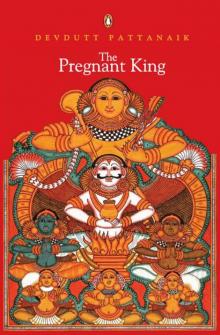 Pregnant King
Pregnant King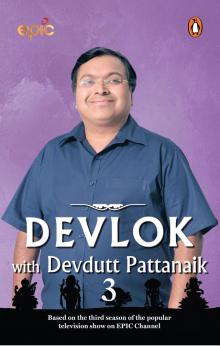 Devlok With Devdutt Pattanaik: 3
Devlok With Devdutt Pattanaik: 3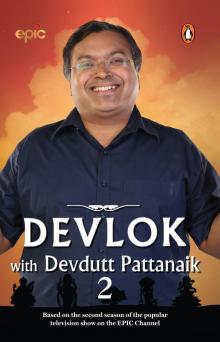 Devlok With Devdutt Pattanaik
Devlok With Devdutt Pattanaik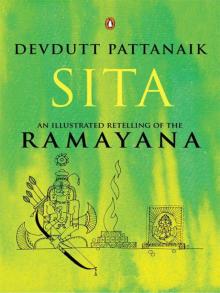 Sita: An Illustrated Retelling of the Ramayana
Sita: An Illustrated Retelling of the Ramayana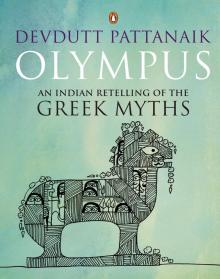 Olympus
Olympus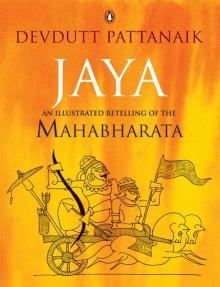 Jaya: An Illustrated Retelling of the Mahabharata
Jaya: An Illustrated Retelling of the Mahabharata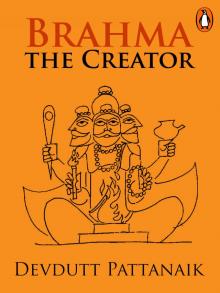 Brahma
Brahma